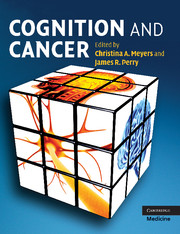Book contents
- Frontmatter
- Contents
- List of contributors
- Preface
- Section 1 Cognition and the brain: measurement, tools, and interpretation
- Section 2 Effects of cancer and cancer treatment on cognition
- 7 Biological bases of radiation injury to the brain
- 8 Cognitive dysfunction related to chemotherapy and biological response modifiers
- 9 Effect of hormones and hormonal treatment on cognition
- 10 Low-grade gliomas
- 11 High-grade gliomas
- 12 Brain metastases
- 13 Primary central nervous system lymphoma
- 14 Childhood brain tumors
- 15 Neurofibromatosis
- 16 Hematological malignancies
- 17 Paraneoplastic disorders
- 18 Symptomatic therapies and supportive care issues
- 19 Animal models and cancer-related symptoms
- Section 3 Interventions and implications for clinical trials
- Index
- Plate section
- References
19 - Animal models and cancer-related symptoms
Published online by Cambridge University Press: 13 August 2009
- Frontmatter
- Contents
- List of contributors
- Preface
- Section 1 Cognition and the brain: measurement, tools, and interpretation
- Section 2 Effects of cancer and cancer treatment on cognition
- 7 Biological bases of radiation injury to the brain
- 8 Cognitive dysfunction related to chemotherapy and biological response modifiers
- 9 Effect of hormones and hormonal treatment on cognition
- 10 Low-grade gliomas
- 11 High-grade gliomas
- 12 Brain metastases
- 13 Primary central nervous system lymphoma
- 14 Childhood brain tumors
- 15 Neurofibromatosis
- 16 Hematological malignancies
- 17 Paraneoplastic disorders
- 18 Symptomatic therapies and supportive care issues
- 19 Animal models and cancer-related symptoms
- Section 3 Interventions and implications for clinical trials
- Index
- Plate section
- References
Summary
Animal models have frequently been useful in developing treatments for a variety of diseases. Their use permits researchers to ask questions about mechanisms that would be difficult or unethical in humans, and also permits the testing of potential treatments. Models that work in rodents are usually preferred because we know much about their physiology and behavior, and because rodents are relatively inexpensive. Moreover, a host of experimental manipulations have been developed for use in these species. Work with primates that may be more valid is substantially more expensive, and the numbers of subjects that can be used are normally very limited. The development of animal models for behavioral symptoms presents a special challenge, because although many such models and tests exist, they address poorly the symptoms that are of most concern to cancer patients. This chapter will provide a selective overview of animal models and tests, and provide examples of what has been achieved in other areas. The limitations of the use of the non-human animal models and tests will also be addressed.
It is important at the outset to note the distinction between an animal model and an animal test. A model is a procedure used to induce a state in the animal that resembles the disease under study. In this context, a test is a procedure that reveals symptoms that resemble aspects of the human disease. For example, in the case of depression, most animal models have relied on chronic stress paradigms.
- Type
- Chapter
- Information
- Cognition and Cancer , pp. 270 - 278Publisher: Cambridge University PressPrint publication year: 2008



